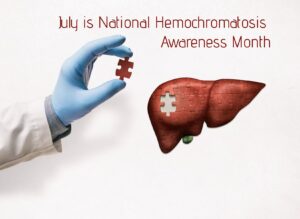July is National Hemochromatosis Awareness Month
Your body needs iron. But, even when it comes to what you need to survive, there is such a thing as too much of a good thing.
Iron is no exception.
Too much iron that builds up in our system is harmful.
The month of July is dedicated to raising awareness surrounding hemochromatosis.
What is Hemochromatosis?
Hemochromatosis is an iron storage disorder. The body absorbs excessive amounts of iron, which leads it to build up in organs, including the liver, heart, pancreas, and joints. Over time, this iron overload results in organ damage and other health complications.
There are two types of hemochromatosis:
- Primary hemochromatosisis also known as hereditary hemochromatosis. It is a genetically inherited disorder. If this is the first time you are learning about hemochromatosis, you may be surprised that it is one of the most common genetic disorders in the United States. Approximately 1 in 225 people have two copies of the HFE gene and are at risk for developing hemochromatosis.
- Secondary hemochromatosismanifests as a result of anemia, alcoholism, and other disorders. When detected early, this type of hemochromatosis has a promising prognosis.
The symptoms of hemochromatosis include:
- Fatigue and weakness
- Joint pain
- Abdominal pain
- Loss of libido
- Changes in skin color
- Abnormal heart rhythm
You’ll notice that these symptoms are pretty generic. They are often associated with several other health conditions.
That makes this disease difficult to pin down. Some people experience no symptoms. It’s not until the iron builds up more and more in specific areas that more warning signs appear.
Screening for hemochromatosis is crucial, especially for anyone with a higher risk factor.
If you have a family history of hemochromatosis or know you possess the HFE gene, you have a higher risk of developing hemochromatosis. Screenings and tests for diagnosis include:
- Liver enzyme tests to determine if there is inflammation
- Testing DNA for mutations if you show high iron levels in the blood
- A liver biopsy to gain a definitive diagnosis
- An MRI to estimate the amount of iron in the liver
A hepatologist is essential to diagnose and treat hemochromatosis effectively. This type of doctor deals directly with diseases and conditions associated with the liver. Turn to The Medical Group of New Jersey when you need a hepatologist in New Jersey. Contact us to learn more!